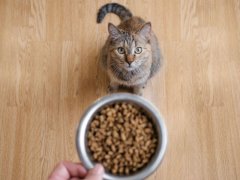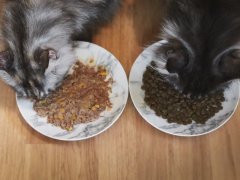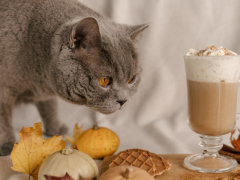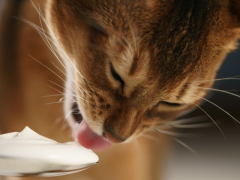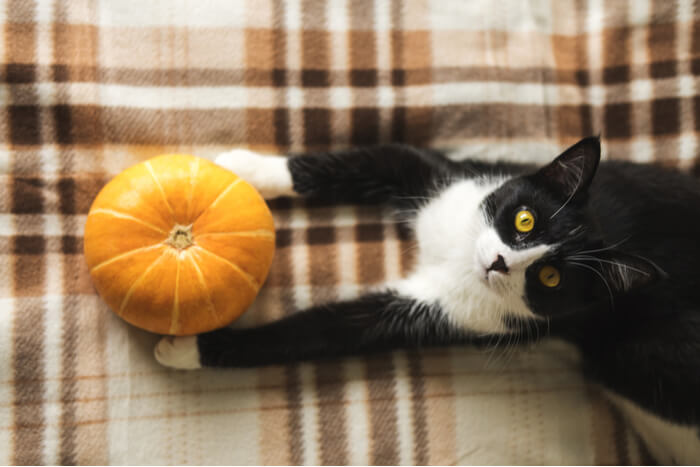
From time to time, we like to give our cat a treat that is tasty and good for them. Fortunately, pumpkin is a safe and healthy treat that offers several health benefits.
In this article, we’ll go over the facts about pumpkin for cats, including pumpkin’s health benefits, safety, and more.
Can Cats Eat Pumpkin?
The answer to this is yes! Pumpkin is not toxic for cats and they can eat pumpkin, but they shouldn’t eat too much of it on a regular basis.
When feeding pumpkin to your cat, you should not add any added sugar or spice to the pumpkin as only fresh pumpkin is safe for cats.
Benefits of Pumpkin for Cats
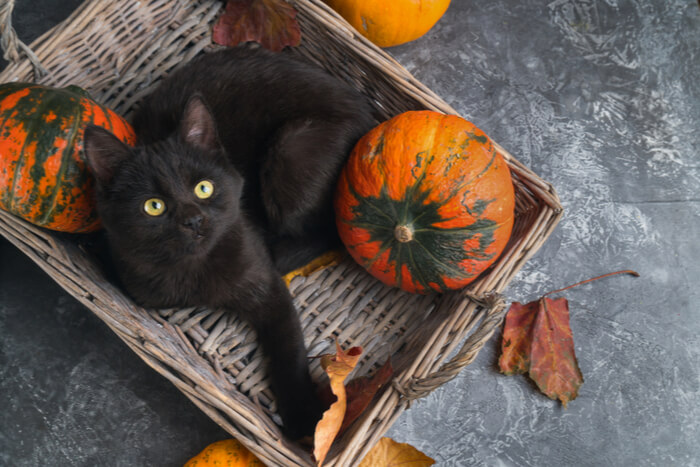
Nutrient-rich with plenty of moisture and a touch of beneficial fibre, pumpkin has benefits for cats with constipation, diarrhea, and more.
Firstly, pumpkin is filled with lots of valuable nutrients. These are beneficial for various parts of your cat’s body. Here’s a short summary of how the nutrients in pumpkin can benefit your cat:
- Vitamin A will help your cat maintain a healthy immune system and good vision
- Alpha-carotene is an antioxidant that can help prevent damage to cells
- Vitamin C can help in enzyme reactions.
- Vitamin Eis a fat soluble antioxidant
- Calcium helps to support bones and teeth
- Iron contributes to cellular respiration and hemoglobin production
- Lutein aids in the overall health of the eyes, skin and coat
There are some benefits that may be seen from feeding pumpkin to cats. If you have any concerns about feeding pumpkin to your cat, then please speak to your veterinary surgeon for more advice.
Pumpkin for Cats With Diarrhea
Pumpkin contains soluble fiber. This soluble fiber helps to absorb excess water in the digestive tract, which can aid in reducing or relieving diarrhea.
Pumpkin is also full off vitamin A, C and E as well as potassium and iron. These along with the fiber content can help to bulk out the stool and absorb water from the digestive tract. Pumpkin is safe and effective but if the diarrhea persists then you should seek advice from your vet.
Also Read: What’s the Best Pumpkin Cat Food? We Tested 6 Products to Find Out
Pumpkin for Cats With Constipation
The combination of fiber and moisture in pumpkin can be of great benefit for cats with constipation. It helps to create bulk, which will stimulate bowel movements.
One tablespoon added to the cat’s normal food in order to ease constipation should help. It is vital to remember that constipation often leads to dehydration so always make sure that your cat has plenty of fresh water available. If the constipation does not resolve, seek veterinary advice .
Read More: Best Cat Food For Constipation
Pumpkin for Weight Control
Again, pumpkin is high in fiber. Fiber in a meal provides bulk, giving the cat a feeling of fullness without the calories. But as with all dietary plans, you should first consult your vet about your cat’s specific needs.
Also in order to use pumpkin to help promote weight loss, it is recommended substituting a portion of your cats food with pumpkin as pumpkin is low in calories but had a good nutritional source to keep our cats happy and healthy.
Pumpkin for Cats With Hairballs
Thanks to its moisture and fiber content, pumpkin can help to ease hairballs in cats in the same way that it can ease constipation. Pumpkin has a laxative affect so it will help the hair move through the digestive tract instead of a hairball.
As we know cats are frequent groomers, and their rough tongue catch loose hair, which is swallowed. While some hair passes through the digestive tract, some get stuck in the stomach and form a hairball.
Seeds for Urinary Tract Health
Pumpkin seeds are high in essential fatty acids and antioxidants, which are great for the skin and fur for our cats. The seeds from the pumpkin are believed to support urinary health. If you choose to serve your cat pumpkin seeds, make sure that they are unseasoned and roasted before serving.
Are There Any Negatives To Feeding Cats Pumpkin?
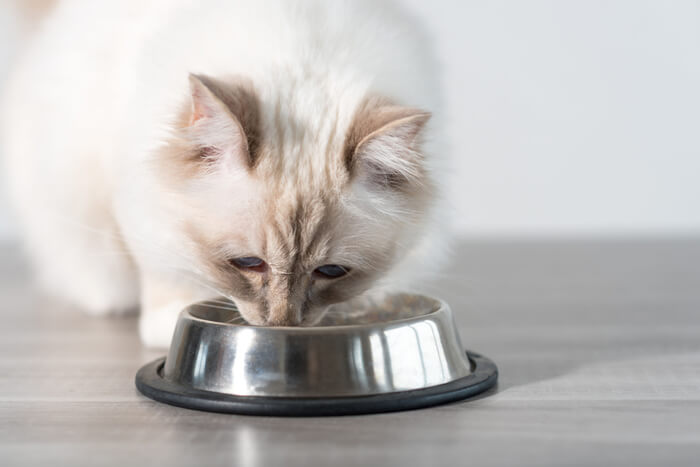
While pumpkin is generally safe for cats, too much pumpkin or eating raw pumpkin can cause GI distress.
Pumpkin is an easy and safe additive, but eating raw pumpkin could lead to vomiting in our cats. For that reason, it’s best to cook pumpkin first before feeding it to your cat. Also, too much pumpkin could cause diarrhea.
If this occurs, feed a smaller amount. If diarrhea continues when feeding the pumpkin, it is possible that your cat can not tolerate pumpkin.
There are certain parts of pumpkin which you should not feed to your cat. These include:
- The stem: Pumpkin stems are prickly and rough on the digestive system, potentially causing a gastrointestinal problem.
- Pumpkin skin: Cats may not digest pumpkin skin well.
- Pulp: Avoid feeding the soft gooey material in the center of the squash.
- Raw pumpkin: As mentioned earlier, raw pumpkin is unsafe for cats.
- Canned pumpkin pie filling: In contrast to plain canned pumpkin, pie filling is loaded with additives. Additives like fillers, spices, or sugar are not safe for your cat’s digestive system.
How to Safely Give Your Cat Pumpkin?
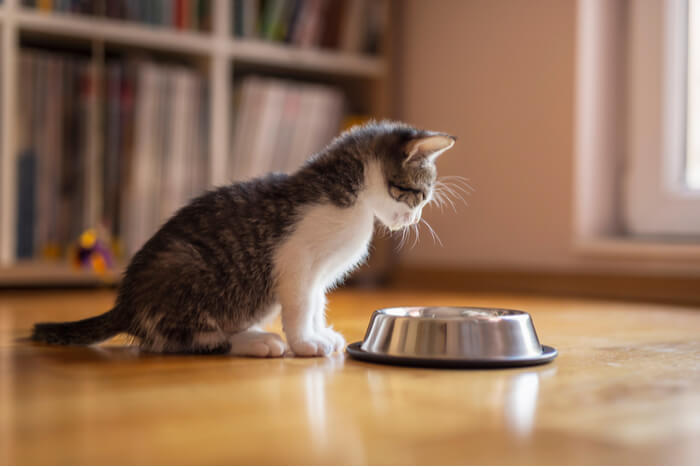
To safely give your cat pumpkin, incorporate small amounts of it into their diet.
It is advisable to start feeding an adult cat with half a teaspoon of pumpkin daily. You can then increase this to a teaspoon after a week or so. Mix the pumpkin into your cat’s meals or, if your cat enjoys the flavor, serve it as a standalone treat.
- Canned pureéd pumpkin is an excellent option, provided that it is made without additives, fillers, spices, or sugar.
- Fresh pumpkin that has been baked is good for cats. Remove the seeds and allow the flesh to cool before feeding to cats.
Pumpkin has some great health benefits, but it’s not for every cat. Like us, cats have varying taste preferences. Some cats might like the taste of pumpkin and some might not.
Additionally, it’s not a solution to health problems. If your cat is unwell, ask your veterinarian for advice.
